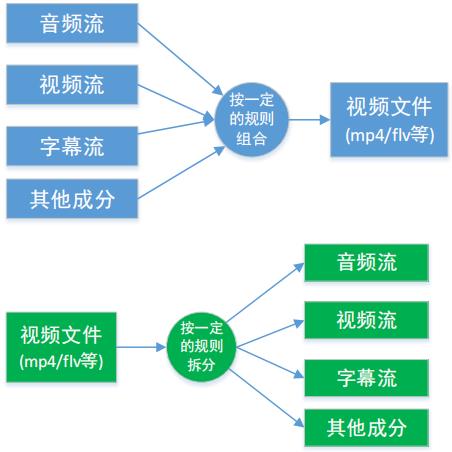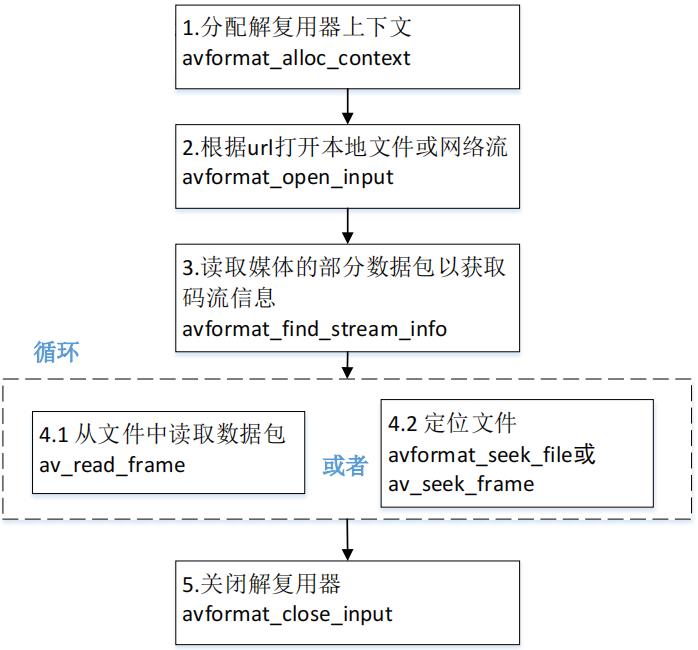流媒体开发19FFMpeg解封装流程分析
Posted 叮咚咕噜
tags:
篇首语:本文由小常识网(cha138.com)小编为大家整理,主要介绍了流媒体开发19FFMpeg解封装流程分析相关的知识,希望对你有一定的参考价值。
1、理解解封装流程和函数调用
2、duration和time_base的理解
一、前言
本节描述使用ffmpeg解封装,解封装其实就是将flv、mp4等文件中的音频和视频数据剥离出来,MP4拆分成AAC和H264文件等。

二、封装相关函数接口
- avformat_alloc_context(): 负责申请一个AVFormatContext结构的内存,并进行简单初始化
- avformat_free_context(): 释放该结构里的所有东西以及该结构本身
- avformat_close_input(): 关闭解复用器,关闭后就不再需要使用avformat_free_context 进行释放。
- avformat_open_input(): 打开输入视频文件(参数1可以传入空的AVFormatContext,内部会进行申请)
- avformat_find_stream_info(): 获取音视频文件信息
- av_read_frame(): 读取音视频包
- avformat_seek_file(): 定位文件。(如:播放器拖动时间轴,1分钟拖到5分钟位置)
- av_seek_frame(): 定位文件。(拖动文件两种方式,按照pts和按照文件大小,如一共10分钟10M,拖动到5分钟则是拖动到5M大小位置)
alloc申请一个AVFormatContext结构的内存,avformat_open_input打开文件将其与AVFormatContext结构体进行关联,之后就可以获取音视频文件的一些信息(大小、时长、编码格式等),然后调用av_read_frame分别读取音频和视频文件。
三、解封装流程

四、区分不同的码流
- AVMEDIA_TYPE_VIDEO视频流
video_index = av_find_best_stream(ic, AVMEDIA_TYPE_VIDEO,-1,-1, NULL, 0)
- AVMEDIA_TYPE_AUDIO音频流
audio_index = av_find_best_stream(ic, AVMEDIA_TYPE_AUDIO,-1,-1, NULL, 0)
AVPacket 里面也有一个index的字段,av_read_frame()获取到的AVPacket的index会和上面av_find_best_stream返回的比较,从而知道当前是视频流还是音频流。
五、重点
- avformat_open_input和avformat_find_stream_info分别用于打开一个流和分析流信息。
- 在初始信息不足的情况下(比如FLV和H264文件),avformat_find_stream_info接口需要在内部调用read_frame_internal接口读取流数据(音视频帧),然后再分析后,设置核心数据结构AVFormatContext。由于需要读取数据包,avformat_find_stream_info接口会带来很大的延迟。
六、demo实现
音频时长换算(对duration和time_base的理解): duration中保存的是采样点的个数,av_q2d(in_stream->time_base)是每个采样点的时间(1s/采样率)
static inline double av_q2d(AVRational a){
return a.num / (double) a.den;
if(in_stream->duration != AV_NOPTS_VALUE)
{
int duration_audio = (in_stream->duration) * av_q2d(in_stream->time_base);
//将音频总时长转换为时分秒的格式打印到控制台上
printf("audio duration: %02d:%02d:%02d\\n",duration_audio / 3600, (duration_audio % 3600) / 60, (duration_audio % 60));
}
解封装信息打印:
#include <stdio.h>
#include <libavformat/avformat.h>
int main(int argc, char **argv)
{
//打开网络流。这里如果只需要读取本地媒体文件,不需要用到网络功能,可以不用加上这一句
// avformat_network_init();
const char *default_filename = "believe.mp4";
char *in_filename = NULL;
if(argv[1] == NULL)
{
in_filename = default_filename;
}
else
{
in_filename = argv[1];
}
printf("in_filename = %s\\n", in_filename);
//AVFormatContext是描述一个媒体文件或媒体流的构成和基本信息的结构体
AVFormatContext *ifmt_ctx = NULL; // 输入文件的demux
int videoindex = -1; // 视频索引
int audioindex = -1; // 音频索引
// 打开文件,主要是探测协议类型,如果是网络文件则创建网络链接
// ifmt_ctx可以为NULL传入,如果是空,avformat_open_input中会去申请内存
int ret = avformat_open_input(&ifmt_ctx, in_filename, NULL, NULL);
if (ret < 0) //如果打开媒体文件失败,打印失败原因
{
char buf[1024] = { 0 };
av_strerror(ret, buf, sizeof(buf) - 1);
printf("open %s failed:%s\\n", in_filename, buf);
goto failed;
}
ret = avformat_find_stream_info(ifmt_ctx, NULL);
if (ret < 0) //如果打开媒体文件失败,打印失败原因
{
char buf[1024] = { 0 };
av_strerror(ret, buf, sizeof(buf) - 1);
printf("avformat_find_stream_info %s failed:%s\\n", in_filename, buf);
goto failed;
}
//打开媒体文件成功
printf_s("\\n==== av_dump_format in_filename:%s ===\\n", in_filename);
av_dump_format(ifmt_ctx, 0, in_filename, 0);
printf_s("\\n==== av_dump_format finish =======\\n\\n");
// url: 调用avformat_open_input读取到的媒体文件的路径/名字
printf("media name:%s\\n", ifmt_ctx->url);
// nb_streams: nb_streams媒体流数量
printf("stream number:%d\\n", ifmt_ctx->nb_streams);
// bit_rate: 媒体文件的码率,单位为bps
printf("media average ratio:%lldkbps\\n",(int64_t)(ifmt_ctx->bit_rate/1024));
// 时间
int total_seconds, hour, minute, second;
// duration: 媒体文件时长,单位微妙
total_seconds = (ifmt_ctx->duration) / AV_TIME_BASE; // 1000us = 1ms, 1000ms = 1秒
hour = total_seconds / 3600;
minute = (total_seconds % 3600) / 60;
second = (total_seconds % 60);
//通过上述运算,可以得到媒体文件的总时长
printf("total duration: %02d:%02d:%02d\\n", hour, minute, second);
printf("\\n");
/*
* 老版本通过遍历的方式读取媒体文件视频和音频的信息
* 新版本的FFmpeg新增加了函数av_find_best_stream,也可以取得同样的效果
*/
for (uint32_t i = 0; i < ifmt_ctx->nb_streams; i++)
{
AVStream *in_stream = ifmt_ctx->streams[i];// 音频流、视频流、字幕流
//如果是音频流,则打印音频的信息
if (AVMEDIA_TYPE_AUDIO == in_stream->codecpar->codec_type)
{
printf("----- Audio info:\\n");
// index: 每个流成分在ffmpeg解复用分析后都有唯一的index作为标识
printf("index:%d\\n", in_stream->index);
// sample_rate: 音频编解码器的采样率,单位为Hz
printf("samplerate:%dHz\\n", in_stream->codecpar->sample_rate);
// codecpar->format: 音频采样格式
if (AV_SAMPLE_FMT_FLTP == in_stream->codecpar->format)
{
printf("sampleformat:AV_SAMPLE_FMT_FLTP\\n");
}
else if (AV_SAMPLE_FMT_S16P == in_stream->codecpar->format)
{
printf("sampleformat:AV_SAMPLE_FMT_S16P\\n");
}
// channels: 音频信道数目
printf("channel number:%d\\n", in_stream->codecpar->channels);
// codec_id: 音频压缩编码格式
if (AV_CODEC_ID_AAC == in_stream->codecpar->codec_id)
{
printf("audio codec:AAC\\n");
}
else if (AV_CODEC_ID_MP3 == in_stream->codecpar->codec_id)
{
printf("audio codec:MP3\\n");
}
else
{
printf("audio codec_id:%d\\n", in_stream->codecpar->codec_id);
}
// 音频总时长,单位为秒。注意如果把单位放大为毫秒或者微妙,音频总时长跟视频总时长不一定相等的
if(in_stream->duration != AV_NOPTS_VALUE)
{
int duration_audio = (in_stream->duration) * av_q2d(in_stream->time_base);
//将音频总时长转换为时分秒的格式打印到控制台上
printf("audio duration: %02d:%02d:%02d\\n",
duration_audio / 3600, (duration_audio % 3600) / 60, (duration_audio % 60));
}
else
{
printf("audio duration unknown");
}
printf("\\n");
audioindex = i; // 获取音频的索引
}
else if (AVMEDIA_TYPE_VIDEO == in_stream->codecpar->codec_type) //如果是视频流,则打印视频的信息
{
printf("----- Video info:\\n");
printf("index:%d\\n", in_stream->index);
// avg_frame_rate: 视频帧率,单位为fps,表示每秒出现多少帧
printf("fps:%lffps\\n", av_q2d(in_stream->avg_frame_rate));
if (AV_CODEC_ID_MPEG4 == in_stream->codecpar->codec_id) //视频压缩编码格式
{
printf("video codec:MPEG4\\n");
}
else if (AV_CODEC_ID_H264 == in_stream->codecpar->codec_id) //视频压缩编码格式
{
printf("video codec:H264\\n");
}
else
{
printf("video codec_id:%d\\n", in_stream->codecpar->codec_id);
}
// 视频帧宽度和帧高度
printf("width:%d height:%d\\n", in_stream->codecpar->width,
in_stream->codecpar->height);
//视频总时长,单位为秒。注意如果把单位放大为毫秒或者微妙,音频总时长跟视频总时长不一定相等的
if(in_stream->duration != AV_NOPTS_VALUE)
{
int duration_video = (in_stream->duration) * av_q2d(in_stream->time_base);
printf("video duration: %02d:%02d:%02d\\n",
duration_video / 3600,
(duration_video % 3600) / 60,
(duration_video % 60)); //将视频总时长转换为时分秒的格式打印到控制台上
}
else
{
printf("video duration unknown");
}
printf("\\n");
videoindex = i;
}
}
AVPacket *pkt = av_packet_alloc();
int pkt_count = 0;
int print_max_count = 10;
printf("\\n-----av_read_frame start\\n");
while (1)
{
ret = av_read_frame(ifmt_ctx, pkt);
if (ret < 0)
{
printf("av_read_frame end\\n");
break;
}
if(pkt_count++ < print_max_count)
{
if (pkt->stream_index == audioindex)
{
printf("audio pts: %lld\\n", pkt->pts);
printf("audio dts: %lld\\n", pkt->dts);
printf("audio size: %d\\n", pkt->size);
printf("audio pos: %lld\\n", pkt->pos);
printf("audio duration: %lf\\n\\n",
pkt->duration * av_q2d(ifmt_ctx->streams[audioindex]->time_base));
}
else if (pkt->stream_index == videoindex)
{
printf("video pts: %lld\\n", pkt->pts);
printf("video dts: %lld\\n", pkt->dts);
printf("video size: %d\\n", pkt->size);
printf("video pos: %lld\\n", pkt->pos);
printf("video duration: %lf\\n\\n",
pkt->duration * av_q2d(ifmt_ctx->streams[videoindex]->time_base));
}
else
{
printf("unknown stream_index:\\n", pkt->stream_index);
}
}
//和av_read_frame对应,av_read_frame中申请内存,但是释放需要我们外部释放
av_packet_unref(pkt);
}
if(pkt)
av_packet_free(&pkt);
failed:
if(ifmt_ctx)
avformat_close_input(&ifmt_ctx);
getchar(); //加上这一句,防止程序打印完信息马上退出
return 0;
}
以上是关于流媒体开发19FFMpeg解封装流程分析的主要内容,如果未能解决你的问题,请参考以下文章